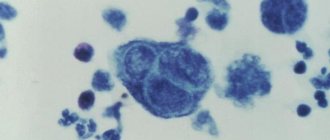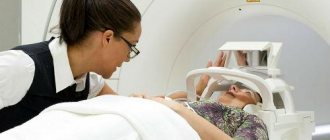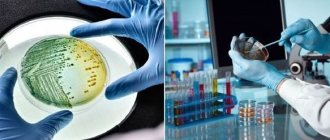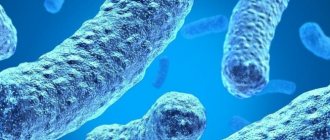Select a city to find an ENT doctor
An eosinophil is a red white leukocyte immune cell that cannot divide. The process of their formation occurs in the bone marrow. This process takes about 4–5 days. After this, they migrate into the blood vessels, from where they continue their journey to all internal organs. The full life cycle is 10–14 days.
Properties of eosinophils:
- antiallergic;
- antiparasitic (helminths and protozoa);
- regenerative;
- reducing the activity of cancer cells.
An absolute increase in the number of cells is called eosinophilia, according to ICD-10 it has a code of D72.1.
Normal indicators
The eosinophil level is an indicator indicating the possible course of the disease. Depends on the level of cortisol produced per day in plasma. Cortisol is susceptible to the influence of medications that a person takes, especially if they are hormonal, to pathological processes and to the psycho-emotional state.
The number of eosinophils above normal indicates the following disorders:
- allergic rhinitis;
- autoimmune processes;
- infectious diseases;
- allergy;
- helminthic infestations.
Below normal indicators indicate the following violations:
- prolonged bacterial and viral infections;
- sepsis;
- purulent-inflammatory processes.
The norm of eosinophils has a gradation relative to a person’s age:
- from birth to 11 months – the indicator ranges from 1 to 4.9 or 5;
- from 11 months to seven years of age – 1–5;
- from 7.5 to 17 years – 1–5.9;
- for adults the indicator corresponds to the range of 1–5.
Individually, when taking an analysis, the percentage of their number in relation to other blood cells is calculated.
For the older generation, the indicator ranges from 1 to 5% of the number of leukocytes (0.02–0.3 cells per 1 μl of blood). For women, it is acceptable for the level of eosinophils to decrease during ovulation and increase before the onset of menstruation.
Changes occur throughout the day, depending on the functioning of the adrenal glands. Morning and evening hours are characterized by a decrease in cell levels, from the daily average, by 20%. At night from 00 to 3–4 am there is an increase. The number of leukocyte cells in the mucus is minimal; you need to take tests in the morning.
Test for eosinophils (rhinocytogram)
Rhinocytogram - examination of nasal discharge under a microscope. With its help, you can identify changes characteristic of allergic reactions of the body or infection. In this way, the cause of inflammation of the nasal mucosa (rhinitis) is determined.
Normally, all the walls of the nasal cavity are covered with a mucous membrane with a secretion that helps remove dust and germs. The secretion has this property due to the presence of ciliated epithelium, which has cilia that are able to vibrate and move mucus along with dust and microbes.
Nevertheless, normally the nasal cavity is inhabited by a large number of microbes (some types of staphylococci, streptococci, etc.) that do not cause harm to humans due to the body’s immune response. If for some reason local immunity decreases, microbes can lead to inflammation, and acute rhinitis occurs - a disorder of nasal function, accompanied by inflammatory changes in the mucous membrane and a runny nose. In addition, rhinitis can be caused by airborne viruses, including acute respiratory infections.
A decrease in local immunity can be caused by hypothermia of the body, a decrease in general human immunity. The development of a runny nose is also facilitated by slowing down the movement of the ciliated epithelium. As a result of the immune system's response, the number of leukocytes - white blood cells - increases in the nasal mucosa. There are several varieties of them; in bacterial infections, neutrophils play the main role in protecting the body; in viral infections, lymphocytes play a major role. Macrophages may also appear.
In case of an allergy, the body is affected by a certain substance (allergen), such as pollen, wool, dust, etc., to which the immune system becomes hypersensitive. This reaction leads to the release of certain substances (histamine, bradykinin) in the nasal mucosa, causing allergy symptoms. Moreover, immune system cells such as eosinophils (one of the types of leukocytes) are of greater importance in this process. In case of allergies, they can appear in large quantities in the blood and also accumulate in the nasal mucus.
In addition, there is vasomotor (neurovegetative) rhinitis, in which exposure to cold, taking certain medications, and exposure to other physical or psycho-emotional factors causes acute swelling of the nasal mucosa and changes in the tone of the vessels of the nasal cavity. In all cases of rhinitis, a large amount of fluid is formed and released, which is what we call a runny nose.
The allergic nature of rhinitis often remains undiagnosed, although it is quite common.
A rhinocytogram can help in diagnosis: the peculiarity of eosinophils appearing in allergic rhinitis is that with a special stain (Romanovsky-Giemsa), they turn red and become available for counting under a microscope. What is the research used for:
- With a long runny nose, in some cases, determining the cause that caused it can be difficult. For this purpose, a rhinocytogram is performed, which reveals an increased number of eosinophils, which serves as an additional argument in favor of the allergic nature of the runny nose. Allergic and infectious rhinitis are treated differently, which is why it is important to determine the cause of the runny nose.
When a study is ordered:
- With prolonged runny nose (several weeks or more), accompanied by nasal congestion, sneezing of unknown origin.
What can influence the result:
- The use of nasal sprays, especially corticosteroids, may lead to false-negative results for eosinophilia.
- The same effect is sometimes observed with the use of tablets containing corticosteroids and antihistamines (anti-allergy) drugs.
Important Notes:
- The results of the study should be assessed by comparing data from the history of the development of the disease, other studies and symptoms.
- To increase the reliability of the results, it is recommended to repeat the examination after 1-2 weeks.
Indicators of the child's body
For children, eosinophil levels have a wider range. Due to the vulnerability of a growing organism, nature has provided increased protection for it:
- up to 1 year – 0.5–5%;
- 1–3 years – 4–7%;
- 4–18 years – 1–5%.
Normally, mucus from the nasopharynx should not contain eosinophils, but their small presence is normal.
If a blood test is taken to determine the number of eosinophils, the normal indicators will be different:
- children under 13 years of age – 0.5–7%;
- adolescents from 13 years of age: 0.5–5%.
How is a smear performed and why?
The procedure for collecting a swab from the nasal throat is simple and painless. But you need to be prudent when it comes to kids. They may get scared and jerk their heads. A cotton swab on a stick will not cause any harm, but discomfort and fear of health workers may remain.
A smear for eosinophils is a quick way to understand the reason why a child’s runny nose does not end. The smear determines the nature of the disease, the degree of development and reactivity of the body.
Analysis regulations:
- the patient first blows his nose;
- throws back his head;
- exhales;
- while inhaling, the physician inserts a cotton swab into the nasal passage;
- the collected liquid is placed in a container.
A smear for eosinophils or a rhinocytogram is performed from the area of the posterior nasal sinus (lower).
The secretions on the cotton swab are stained with acidic inhibitors, they react and act on the heterogeneity of blackening of the photographic material. Eosinophilic white blood cells stain red and become available for counting under a laboratory microscope.
A study is carried out if the patient complains of the following disorders:
- breathing problems;
- constant sneezing, secretion from the nasal cavity;
- itching;
- swelling;
- tearfulness.
Microscopic examination of a smear from the nasal mucosa
A rhinocytogram is a study of mucus from the nasal cavity under a microscope. It allows you to determine the presence in the nasal mucus of cells characteristic of allergic or infectious diseases that cause rhinitis - inflammation of the nasal mucosa. With a long runny nose, in some cases, determining the cause that caused it can be difficult. For this purpose, a rhinocytogram is performed, which reveals an increased number of eosinophils, which serves as an additional argument in favor of the allergic nature of the runny nose. Allergic and infectious rhinitis are treated differently, which is why it is important to determine the cause of the runny nose. Reference values are not given. The result is a description of the general cytological picture with a count of the number of leukocytes, eosinophils, neutrophils, ciliated epithelium, lymphocytes, macrophages, mucus, erythrocytes, yeast fungi, flora. The doctor interprets the result (differential diagnosis of rhinitis) by assessing the ratio of the number of cells.
Synonyms Russian
Rhinocytogram, cytological examination of secretions from the nasal cavity, smear for eosinophilia, examination of scrapings from the nasal mucosa, examination of nasal secretions.
English synonyms
Cytologic study of respiratory tract, Nasal Smear, Nasal smear for eosinophils, Eosinophil smear.
Research method
Microscopy.
What biomaterial can be used for research?
Nasal swab.
How to properly prepare for research?
Avoid the use of nasal sprays and drops containing corticosteroids for 24 hours before the test.
General information about the study
Rhinocytogram - examination of nasal discharge under a microscope. With its help, you can identify changes characteristic of allergic reactions of the body or infection. In this way, the cause of inflammation of the nasal mucosa (rhinitis) is determined.
Normally, all the walls of the nasal cavity are covered with a mucous membrane with a secretion that helps remove dust and germs. The secretion has this property due to the presence of ciliated epithelium, which has cilia that are able to vibrate and move mucus along with dust and microbes.
Nevertheless, normally the nasal cavity is inhabited by a large number of microbes (some types of staphylococci, streptococci, etc.) that do not cause harm to humans due to the body’s immune response. If for some reason local immunity decreases, microbes can lead to inflammation, and acute rhinitis occurs - a disorder of nasal function, accompanied by inflammatory changes in the mucous membrane and a runny nose. In addition, rhinitis can be caused by airborne viruses, including acute respiratory infections.
A decrease in local immunity can be caused by hypothermia of the body, a decrease in general human immunity. The development of a runny nose is also facilitated by slowing down the movement of the ciliated epithelium.
As a result of the immune system's response, the number of leukocytes - white blood cells - increases in the nasal mucosa. There are several varieties of them; in bacterial infections, neutrophils play the main role in protecting the body; in viral infections, lymphocytes play a major role. Macrophages may also appear.
In case of an allergy, the body is affected by a certain substance (allergen), such as pollen, wool, dust, etc., to which the immune system becomes hypersensitive. This reaction leads to the release of certain substances (histamine, bradykinin) in the nasal mucosa, causing allergy symptoms. Moreover, immune system cells such as eosinophils (one of the types of leukocytes) are of greater importance in this process. In case of allergies, they can appear in large quantities in the blood and also accumulate in the nasal mucus.
In addition, there is vasomotor (neurovegetative) rhinitis, in which exposure to cold, taking certain medications, and exposure to other physical or psycho-emotional factors causes acute swelling of the nasal mucosa and changes in the tone of the vessels of the nasal cavity.
In all cases of rhinitis, a large amount of fluid is formed and released, which is what we call a runny nose.
The allergic nature of rhinitis often remains undiagnosed, although it is quite common. A rhinocytogram can help in diagnosis: the peculiarity of eosinophils appearing in allergic rhinitis is that with a special stain (Romanovsky-Giemsa), they turn red and become available for counting under a microscope.
What is the research used for?
With a long runny nose, in some cases, determining the cause that caused it can be difficult. For this purpose, a rhinocytogram is performed, which reveals an increased number of eosinophils, which serves as an additional argument in favor of the allergic nature of the runny nose. Allergic and infectious rhinitis are treated differently, which is why it is important to determine the cause of the runny nose.
When is the study scheduled?
With prolonged runny nose (several weeks or more), accompanied by nasal congestion, sneezing of unknown origin.
What do the results mean?
Reference values for various types of microorganisms depend on their location (point of collection of biological material).
Increasing performance
- Eosinophils. A significant increase (more than 10% of the total number of leukocytes in a smear or more) in the number of eosinophils indicates an allergic origin of the runny nose. At the same time, it should be borne in mind that the absence of a large number of eosinophils in the smear does not reliably exclude the allergic nature of the disease. Eosinophil levels may also be elevated in non-allergic eosinophilic rhinitis, a disease in which there are no other signs (besides an increase in the number of eosinophils in the blood and nasal mucus) of an allergy. The disease is often accompanied by polyps and lack of response to antiallergic (antihistamine) drugs.
- Neutrophils. An increase in the number of these cells in a smear may indicate that the cause of a runny nose is infectious agents (bacteria or viruses). An increase in the level of neutrophils is especially characteristic of the acute stage of the disease.
- Lymphocytes. An increased content of lymphocytes may be associated with chronic infectious inflammation of the nasal mucosa.
- Red blood cells. The appearance of red blood cells in a smear may indicate increased permeability of the vascular wall of the nasal mucosa, which is typical for some types of rhinitis, in particular those caused by diphtheria or influenza.
It should be noted that increased levels of neutrophils and lymphocytes are not specific for infection.
Decrease in indicators
The absence of eosinophils, neutrophils, and other types of leukocytes in the smear may indicate:
- vasomotor rhinitis - runny nose not associated with allergies or infections;
- rhinitis associated with abuse of vasoconstrictor nasal sprays;
- rhinitis caused by other reasons (hormonal disorders, disorders of the psycho-emotional state, disorders of the anatomy of the nasal passages, etc.).
What can influence the result?
The use of nasal sprays, especially corticosteroids, may lead to false-negative results for eosinophilia.
The same effect is sometimes observed with the use of tablets containing corticosteroids and antihistamines (anti-allergy) drugs.
Important Notes
- The results of the study should be assessed by comparing data from the history of the development of the disease, other studies and symptoms.
- To increase the reliability of the results, it is recommended to repeat the examination after 1-2 weeks.
Also recommended
- Complete blood count (without leukocyte formula and ESR)
- Total immunoglobulin E (IgE) in serum
Who orders the study?
General practitioner, general practitioner, otorhinolaryngologist, allergist-immunologist.
Literature
- Palchun V. T. Otorhinolaryngology. National leadership, 2008, GEOTAR-media. 919 pp.
- V Paleri, J Hill. ENT Infections: An Atlas of Investigation and Management, 2010, Atlas Medical Publishing Ltd. P. 116.
- Dan L. Longo, Dennis L. Kasper, J. Larry Jameson, Anthony S. Fauci, Harrison's principles of internal medicine (18th ed.). New York: McGraw-Hill Medical Publishing Division, 2011.
Results and their interpretation
The patient receives the results of the study within the first 24 hours; deciphering the indicators takes a little time.
Normal smear values for eosinophils based on the total number of cells:
- lymphocytes – up to 5%;
- neutrophils – single quantity;
- eozonophiles – up to 7–10%;
- red blood cells – several units;
- epithelial cells – several units;
- cocci – none at all or a few units.
The norms are valid for both children and adults, but after 13 years the norms become lower and reach a level of 5–7%.
What do deviations from the norm indicate:
- The level of neutrophil cells is elevated - the bacterial nature of the disease.
- Lymphocytic cytosis is a viral course of the disease.
- Eosinophils and neutrophils in large numbers - the associated secondary infection caused a complication of hypersensitivity.
- The absence of eosinophils, along with other leukocytes – vasomotor rhinitis.
- An increase in the level of eosinophils by two or three times is an allergic reaction.
Allergies are caused by the following diseases:
- hay fever;
- seasonal Qatar;
- hypersensitive rhinitis;
- periarteritis nodosa;
- leukemia;
- bronchial asthma;
- ascariasis.
The test for eosinophils is sometimes unreliable if a nasal swab was taken during pregnancy or after recent surgical treatment.
Modern treatment
Rhinopharyngitis is an inflammation of the nasopharyngeal mucosa; an increased level of eosinophils in the smear will be an indicator of the nature of the current process. When you take the test, it will become clear what treatment the doctor will prescribe: antihistamines or antivirals.
Complete treatment of rhinopharyngitis is carried out after consultation with a pediatrician or therapist. But the main actions are carried out by a hematologist, because the increased content of these cells is only a symptom of the underlying disorder.
The cause of this condition must be further identified, a biochemical blood test is performed, and enzyme levels are checked. The drugs prescribed to treat this condition depend on its causes.
ethnoscience
Folk remedies for violation:
- Gargling with chamomile or calendula, sea salt.
- If a child does not know how to gargle, doctors advise using inhalation with soda solution or mineral water.
- If the child is an adult over 5 years old, then he is allowed to take Strepsils.
- Steam inhalation of boiled potatoes.
- Rinse the nasal passages with saline solution.
- Additionally, it is necessary to carry out mechanical cleansing, suctioning out excessively secreted secretions from the nasal passages.
- Regular ventilation of the room.
- Prevention of dysbacteriosis. Many drugs interfere with intestinal function; simple kefir partially neutralizes the effects of treatment.
- Foot baths with mustard, mustard plasters.
To stimulate coughing, which is inevitable when secretions flow down the back wall of the throat, it is necessary to carry out the recommended manipulations.
24 hours before taking a nasal swab, you should stop taking nasal medications with corticosteroids. It is necessary to exclude vasoconstrictors, antibacterial, antiallergic drugs.
Before the procedure, you need to clear the nasal passages of excess mucus. The patient should not blow his nose, the pressure will cause the destruction of the vessel wall, and blood particles will fall on the mucous membrane. This result will give false results in the eosinophil test.
Scraping from the nasal mucosa for eosinophils (nosogram)
A nosogram is a study of mucus from the nasal cavity under a microscope. It allows you to determine the presence in the nasal mucus of cells characteristic of allergic or infectious diseases that cause rhinitis - inflammation of the nasal mucosa.
Research method
Microscopy.
What biomaterial can be used for research?
Nasal swab.
How to properly prepare for research?
Avoid the use of nasal sprays and drops containing corticosteroids for 24 hours before the test.
General information about the study
Nosogram - examination of nasal discharge under a microscope. With its help, you can identify changes characteristic of allergic reactions of the body or infection. Thus, the cause of inflammation of the nasal mucosa (rhinitis) is established.
Normally, all the walls of the nasal cavity are covered with a mucous membrane with a secretion that helps remove dust and germs. However, the nasal cavity is normally home to a large number of microbes that do not cause harm to humans due to the body's immune response. If for some reason local immunity decreases, microbes can lead to inflammation, acute rhinitis (runny nose) occurs - a disorder of nasal function, accompanied by inflammatory changes in the mucous membrane and runny nose. In addition, rhinitis can be caused by airborne viruses, including acute respiratory infections.
As a result of the immune system's response, the number of leukocytes - white blood cells - increases in the nasal mucosa.
In case of an allergy, the body is affected by a certain substance (allergen), such as pollen, wool, dust, etc., to which the immune system becomes hypersensitive. This reaction leads to the release of certain substances (histamine, bradykinin) in the nasal mucosa, causing allergy symptoms. Moreover, immune system cells such as eosinophils (one of the types of leukocytes) are of greater importance in this process. In case of allergies, they can appear in large quantities in the blood and also accumulate in the nasal mucus.
In all cases of rhinitis, a large amount of fluid is formed and secreted, which is what we call a runny nose.
What is the research used for?
With a long runny nose, in some cases, determining the cause that caused it can be difficult. For this purpose, a rhinocytogram is performed, which reveals an increased number of eosinophils, which serves as an additional argument in favor of the allergic nature of the runny nose. Allergic and infectious rhinitis are treated differently, which is why it is important to determine the cause of the runny nose.
What do the results mean?
Reference values for various types of microorganisms depend on their location (point of collection of biological material).
Increasing performance
- Eosinophils. A significant increase (more than 10% of the total number of leukocytes in a smear or more) in the number of eosinophils indicates an allergic origin of the runny nose.
- Neutrophils. An increase in the number of these cells in a smear may indicate that the cause of a runny nose is infectious agents (bacteria or viruses). An increase in the level of neutrophils is especially characteristic of the acute stage of the disease.
- Lymphocytes. An increased content of lymphocytes may be associated with chronic infectious inflammation of the nasal mucosa.
- Red blood cells. The appearance of red blood cells in a smear may indicate increased permeability of the vascular wall of the nasal mucosa, which is typical for some types of rhinitis, in particular those caused by diphtheria or influenza.
It should be noted that increased levels of neutrophils and lymphocytes are not specific for infection.
Decrease in indicators
The absence of eosinophils, neutrophils, and other types of leukocytes in the smear may indicate:
- vasomotor rhinitis - runny nose not associated with allergies or infections;
- rhinitis associated with abuse of vasoconstrictor nasal sprays;
- rhinitis caused by other reasons (hormonal disorders, disorders of the psycho-emotional state, disorders of the anatomy of the nasal passages, etc.).
What can influence the result?
The use of nasal sprays, especially corticosteroids, may lead to false-negative results for eosinophilia.
The same effect is sometimes observed with the use of tablets containing corticosteroids and antihistamines (anti-allergy) drugs.










